|
Books
|
The
Cactus Family
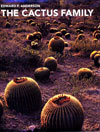
Edward F. Anderson |
Undisputedly, The Cactus Family has been the ultimate
resource for everything I hoped to learn about cacti. Published
in 2001, it is also the most modern book on the subject that
I know of. This 776 page hardcover is packed with information
on each individual species of known cacti in an easy-to-use,
encyclopedia-like format. Additional full-length comprehensive
chapters include:
-Distinctive features of Cacti
-Ethnobotany of Cacti
-Conservation of Cacti
-Cultivation of Cacti
-Classification of Cacti
Also in this book is an Index of Scientific Names that I
have found absolutely indispensable in finding the proper,
updated information on classification. An Index of Common
Names, an Appendix with Maps of various regions where cacti
grow, and an Appendix of Botanic Gardens and Herbaria with
Significant Collections of Cacti further the usefulness of
this fantastic book.
If you are at all serious about expanding your knowledge
on cacti, then you MUST get this book!
|
Cacti of the Desert Southwest
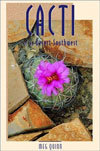
Meg Quinn |
Also published in 2001, Meg Quinn
must have finished this book shortly after The Cactus Family
was released, since she based the scientific names in her book
Cacti of the Desert Southwest on those listed in The
Cactus Family. The nomenclature used in this book is therefore
up-to-date. I found this wonderfully well-organized book specific
to cacti of the southwest very practical as a field guide while
traveling through the deserts of the southwest. Large, full-color
photography coupled with specific information on the distribution/range
of each species makes identification a snap. Quinn's book is
an 88 page soft-cover that I would recommend to anyone who is
planning a visit to the Desert Southwest. |
Cacti of the Southwest
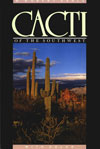
W. Hubert Earle |
This book is a little older; published
originally in 1963 and later updated in 1980, it specifically
covers cacti of the Southwest. I found the most helpful feature
of this book to be individual photos printed for each variety
within a specific species. Given the extremely variable
growth characteristics of Cacti, having these photos -although
black and white- makes identification of variations much easier.
A separate section of color photos was added when the book was
updated in 1980. The color photos primarily represent the flower
close-up for each species. Despite being over 20 years old,
this book can be as useful as any modern book when used in conjunction
with the Index to Scientific Names in The Cactus Family. |
70 Common Cacti
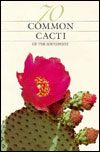
Pierre C. Fischer |
At approximately 8 bucks, 70 Common
Cacti is well worth the money. Published in 1989, it is
the cacti-specific book in a series of books produced by Southwest
Parks and Monuments Association. The pages aren't numbered and
I didn't bother counting, but it is approximately 80 pages.
There are lots of photos that are vary useful for identification
purposes. Distribution/Range information also proves helpful
along with non-technical descriptions that even beginners can
relate to. |
Cacti, The Illustrated Dictionary
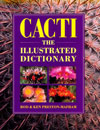
Rod & Ken Preston-Mafham |
Have an unknown cacti potted on your
window sill? If so, you'll probably be able to identify it using
Cacti, The Illustrated Dictionary. This book is specific
to the identification of the globular cacti that are commonly
collected by enthusiasts with potted collections. Hundreds of
photos help simplify the identification of such genera as Echinocereus,
Mammillaria, Parodia, and many more. This book was first
published in 1991 and later revised in 1994. Out of 224 pages,
over 200 of them feature color photos of each the species as
well as photos of varieties. |
|
The Native Cacti of California
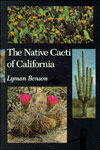
Lymnon Benson
|
For those who wish to explore California and view its wild
cacti, this book makes the task much easier. Within the 243
pages you will find general cacti biology information, identification
and classification information as it relates specifically
to the native species of California. Also geographical and
climatic information regarding California's different vegetative
zones are included. Some of this information may be outdated
as the book was first published in 1969, but the majority
of information is still very useful to those interested in
the subject. This book is packed with line drawings, color
plates, and black and white photos useful for identification
as well as 18 maps showing the distribution/native location
of each species. The Native Cacti of California is
a wonderful resource for locating the widely spread out species
in the large state of California.
|
Cactus
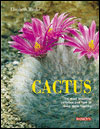
Elisabeth Manke |
The photographs alone warrant the purchase of this cacti
specific book. All but 7 out of 160 pages are graced with
one or more fantastic pictures of show-quality specimens,
which are great for identification or merely for viewing pleasure.
The focus of this 1998 book is on the care and propagation
of cacti with general information on potting, seeding, cutting,
and grafting as well as a per-species water-temperature-soil
requirement listing. Approximately 50 species are described
in an easy-to-follow format. Although many will find the selection
sufficient, I find the only drawback of this book is that
it doesn't cover more species.
|
The Illustrated Guide to Cacti
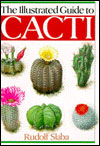
Rudolf Slaba |
This book was given to me as a gift
and for a time it was my only book on cacti. This book has 224
pages and has illustrations rather than photographs. Published
in 1992, this book's features cacti that are popularly grown
by the amateur cacti enthusiast. The combination of the use
of illustrations and selective coverage prevents this from being
one of the better books for identifying various species. However,
this book contains a wealth of information on growing and caring
for cacti. Subjects covered include: Repotting, Watering, Seeding,
Grafting, and Disease and Pest Control. This makes it an excellent
book for those looking for help learning how to grow cacti successfully. |

